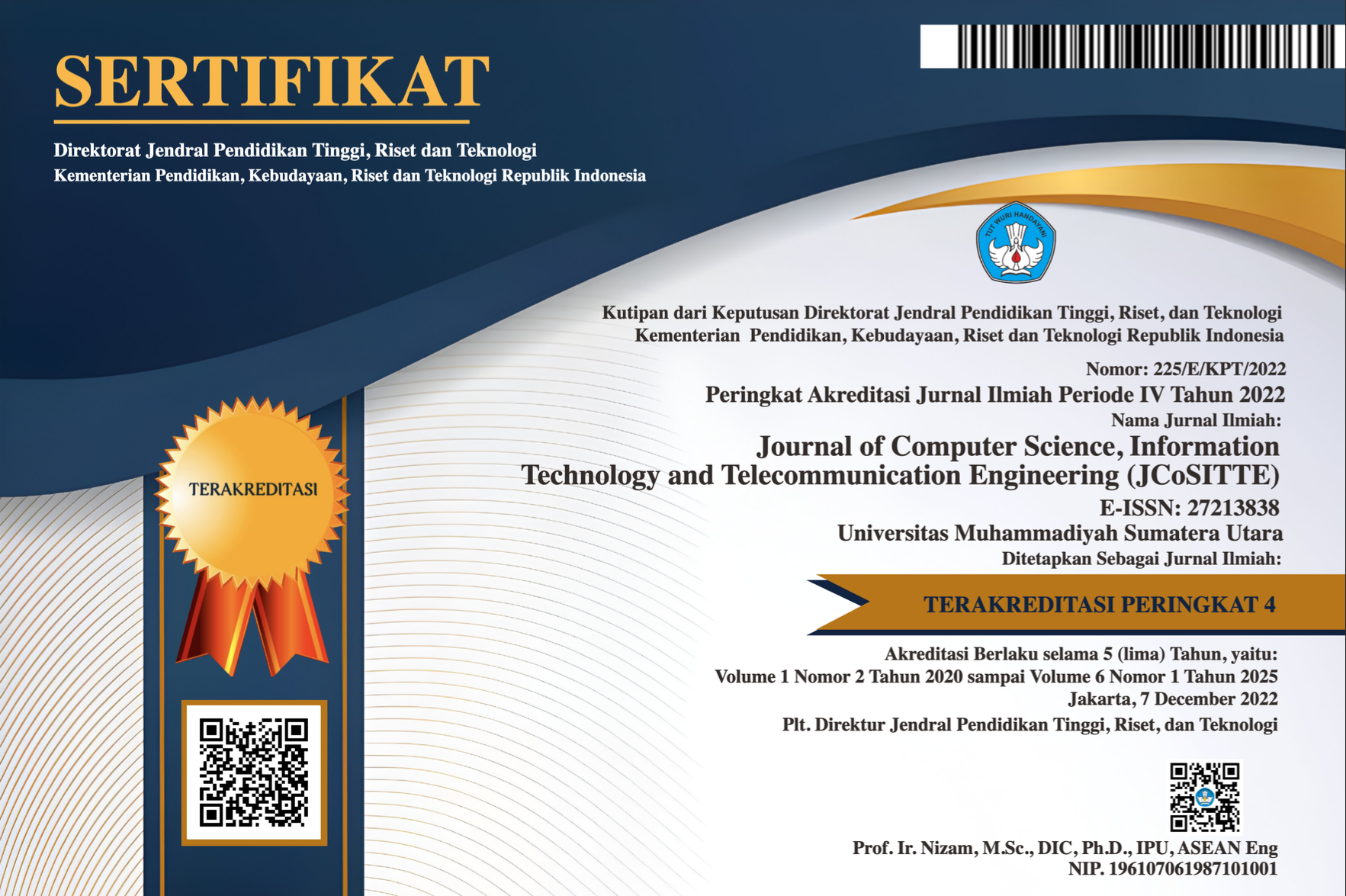Cluster Analysis Using K-Means Algorithm and Fuzzy C- Means Clustering For Grouping Students' Abilities In Online Learning Process
Abstract
The time of the Covid-19 pandemic, which is still unknown when it will end, has resulted in the learning and teaching process having to be carried out online. The impact of the learning process carried out online is a less satisfactory result than the learning process carried out offline. This study aims to group students based on their learning outcomes in statistics courses and measured probability based on the variables of attendance scores, assignments, midterm exams (UTS), and final semester exams (UAS) which are then used to evaluate learning for subjects that require analytical skills. good quantitative. This study uses cluster k-means analysis and fuzzy C-Means in grouping students into three groups based on their learning outcomes. After being grouped,
Full Text:
PDFReferences
Al-Khowarizmi, A. K., Fauzi, F., Sari, I. P., & Sembiring, A. P. (2020). The effect of indonesian and hokkien mobile learning application models. Journal of Computer Science, Information Technology and Telecommunication Engineering, 1(1), 1-7.
Borkowska-Niszczota, M., 2015. Tourism Clusters in Eastern Poland - Analysis of Selected Aspects of the Operation. Procedia - Social and Behavioral Sciences, 213, pp. 957964. Available at: http://linkinghub.elsevier.com/retrieve/pii/ S1877042815058668.
Muningsih, E. & Kiswati, S., 2015. Application of the K-Means Method for Online Shop Product Clustering Determination of Stocks of Goods. Bianglala Informatics Journal, 3 (1), pp.1017.
Nasari, F., Darma, S. & Information, S., 2015. Implementation of K-Means Clustering in Student Admission Data New. National Seminar on Information and Multimedia Technology 2015, 10 (2), pp. 7378.
Ong, JO, 2013. Implementation of the K-Means Clustering Algorithm to Determine the Marketing Strategy. Journal Ilimiah Industrial Engineering, 12 (1), pp. 1020.
Rivani, E., 2010. Application of K-Means Cluster for Grouping Provinces based on Production of Rice, Maize, Soybeans, and Mung Beans 2009. Mat Stat, 10 (2), pp. 122134.
Poerwanto, B. & Fa'rifah, RY, 2016. Cluster Analysis Using the K-Means Algorithm. d'ComputarE, 6 (2), pp. 6277
Al-Khowarizmi, A. K., Nasution, I. R., Lubis, M., & Lubis, A. R. (2020). The effect of a SECoS in crude palm oil forecasting to improve business intelligence. Bulletin of Electrical Engineering and Informatics, 9(4), 1604-1611.
Prayudani, S., Hizriadi, A., Lase, Y. Y., & Fatmi, Y. (2019, November). Analysis Accuracy Of Forecasting Measurement Technique On Random K-Nearest Neighbor (RKNN) Using MAPE And MSE. In Journal of Physics: Conference Series(Vol. 1361, No. 1, p. 012089). IOP Publishing.
Ramadhani, F., & Ilona, D. (2018). Determinants of web-user satisfaction: using technology acceptance model. In MATEC Web of Conferences (Vol. 248, p. 05009). EDP Sciences.
Ramadhani, F., Ramadhani, U., & Basit, L. (2020). Combination of Hybrid Cryptography In One Time Pad (OTP) Algorithm And Keyed-Hash Message Authentication Code (HMAC) In Securing The Whatsapp Communication Application. Journal of Computer Science, Information Technology and Telecommunication Engineering, 1(1), 31-36.
Ramadhani, F., Zarlis, M., & Suwilo, S. (2020). Improve BIRCH algorithm for big data clustering. In IOP Conference Series: Materials Science and Engineering (Vol. 725, No. 1, p. 012090). IOP Publishing.
Syah, R., Nasution, M. K., & Elveny, M. (2021). Sensitivity of MAPE using detection rate for big data forecasting crude palm oil on k-nearest neighbor. International Journal of Electrical & Computer Engineering (2088-8708), 11(3).
Sari, I. P., Hutagalung, F. S., & Hutasuhut, B. K. (2020). Determination of Campus Promotion Policy Strategy Applied The Profile Matching Method. Journal of Computer Science, Information Technology and Telecommunication Engineering, 1(1), 17-23.
Hutagalung, F. S., Mawengkang, H., & Efendi, S. (2019). Kombinasi Simple Multy Attribute Rating (SMART) dan Technique For Order Preference by Similarity To Ideal Solution (TOPSIS) dalam Menentukan Kualitas Varietas Padi. InfoTekJar: Jurnal Nasional Informatika dan Teknologi Jaringan, 3(2), 109-115.
Sari, I. P., Hutagalung, F. S., & Hutasuhut, B. K. (2020). Analisa Model Pemanfaatan Jaringan Komputer Yang Efektif untuk Peningkatan Produktivitas pada Jaringan LAN Universitas Muhammadiyah Sumatera Utara. InfoTekJar: Jurnal Nasional Informatika dan Teknologi Jaringan, 5(1), 193-197.
Hutagalung, F. S., Sari, I. P., & Hutasuhut, B. K. (2020). Analisa SWOT Strategi Perencanaan Pemasaran Fakultas Ilmu Komputer dan Teknologi Informasi Universitas Muhammadiyah Sumatera Utara. InfoTekJar: Jurnal Nasional Informatika dan Teknologi Jaringan, 5(1), 198-201.
Lubis, A. R., Lubis, M., & Listriani, D. (2019, August). Big Data Forecasting Applied Nearest Neighbor Method. In 2019 International Conference on Sustainable Engineering and Creative Computing (ICSECC) (pp. 116-120). IEEE.
Lubis, A. R., & Prayudani, S. (2020, October). Optimization of MSE Accuracy Value Measurement Applying False Alarm Rate in Forecasting on Fuzzy Time Series based on Percentage Change. In 2020 8th International Conference on Cyber and IT Service Management (CITSM) (pp. 1-5). IEEE.
Qiao, W., & Yang, Z. (2019). An improved dolphin swarm algorithm based on Kernel Fuzzy C-means in the application of solving the optimal problems of large-scale function. IEEE Access, 8, 2073-2089.
DOI: https://doi.org/10.30596/jcositte.v2i1.6504
Refbacks
- There are currently no refbacks.





.png)

